poemata latina (15 Ergebnisse)
Produktart
- Alle Produktarten
- Bücher (15)
- Magazine & Zeitschriften
- Comics
- Noten
- Kunst, Grafik & Poster
- Fotografien
- Karten
-
Manuskripte &
Papierantiquitäten
Zustand
- Alle
- Neu
- Antiquarisch/Gebraucht
Einband
Weitere Eigenschaften
- Erstausgabe (1)
- Signiert
- Schutzumschlag
- Angebotsfoto (10)
Land des Verkäufers
Verkäuferbewertung
-
Poemata, latina & graeca, quotquot colligi potuerunt.
Anbieter: Antiquariaat Brinkman, since 1954 / ILAB, Amsterdam, Niederlande
Utrecht, G. Broedelet, 1694. [viii],62,[2] pp. Full calf, gilt spine w. morocco title piece. (leather a bit damaged by oxidation, sl.used, stamp on flyleaves and title, upper corner first 3 leaves repaired). Preface by J.G.Graevius.
-
Poemata latina et graeca. Editio post plurimas postrema, longe auctior.
Verlag: Amsterdam, Johannes Janssonius, 1649., 1649
Anbieter: Charbo's Antiquariaat, Amsterdam, Niederlande
(XII)+666+(2) pp. With engr. additional title. Hardcover. Contemp. vellum. Good. (Binding sl. stained; old owner's inscr. on endp. & on engr. title, tear in last text leaf closed). * Willems 1613.
-
Varia Poemata Graeca & Latina. Hymni. Idyllia. Funera. Odae. Epigrammata. Anagrammata.
Verlag: Antwerp Plantin/Moretus, 1593
Erstausgabe
First edition.4to (230 x 165 mm). A-S4: 141, (2) p. A bit toned. Ex-libris on paste-down. Contemporary limp vellum. - Adams J-59; ustc 406950.Some quotations from Th. Schmitz, Les odes grecques de Frédéric Jamot (d. ca. 1609)*: "Before turning to these odes themselves, it is necessary to give some bibliographical details about this author - I say bibliographical and not biographical because, as we shall see, his life remains almost unknown. Although he seems to have been a skilful philologist and esteemed by his contemporaries, he is practically forgotten today . Yet he seems to me to deserve a more thorough study than I shall try to give here [.].Most of his works are in Latin and Greek [.] He stayed in Paris, where he studied at the College de Cocqueret with Strahle, Galland, Turnèbe and Dorat. It is likely that it was the latter who introduced him to the odes of Pindar. In 1578 Jamot joined the album amicorum of Bonaventure Vulcanius when the latter was in Bethune. He was a physician and had two children, Pierre and Charles, as he himself testifies.Fortunately, we know more about Jamot's publications than about his life: his name appears for the first time in 1552, in a small book containing the first idyll of Theocritus [.] In 1557, Jamot edited the poem of Triphiodorus [followed by] a contribution of three poems to the collection of epitaphs for the death of Jean Strazel [.] Two years later, it was again the death of one of his professors that made him take up the pen: De obitu Petri Gallandij - the idyll is a Greek translation of a poem by Ausone [highly esteemed by the editors Jean Crispin and Henri Estienne].In 1566, Jamot took part in a translation in Greek verse of some psalms [.] In 1567 Jamot's only French work appeared, a translation of a medical treatise by Demetrius Pepagomene, a fifteenth-century Byzantine physician [.] Five years after the Varia Poemata, Jamot published a small book containing only three poems: Parodia Pindarica [Douai 1598]. In 1611, Jamot published more pieces in honour of Charles l'Ecluse [.] Since l'Ecluse died on 4 April 1609, as we read in the funeral oration, this date is the terminus post quem for Jamot's death. He was probably born between 1520 and 1530 and reached a considerable age. [In Schmitz' article follows a detailed analysis of Jamot's pindarique odes. Towards the end Schmitz writes:] In his seven Pindaric odes, Jamot succeeded in finding the tone and style of his model. But he tried to standardize the Epinicies according to the rules of rhetoric, and for him, the "beautiful disorder" of the Thebain that so struck Boileau was not the most important aspect of Pindar's odes. Thus it can be said that Frederic Jabot imitated Pindar without, however, 'pindarising'."The Funera are on Johannes Strasellus, Pierre Galland, Adrian Turnèbe, Franciscus Gryphius and a few more; the odes, anagramms, idyllia are dedicated to George Buchanan, Joachim Du Bellay, Henri Estienne, Johannes Carpentarius, Fédéric Morel, Jean Dorat, Justus Lipsius, Johannes Moretus and some more.????????* Bibliothèque d'humanisme et renaissance, 1991, vol. 53, pp. 281-303.
-
Danielis Heinsii Poemata Latina et Graeca; Editio post plurimas postrema longe auctior.
Verlag: Amsterdam (Amstelodami), Apud Joannem Janssonium, 1649., 1649
Anbieter: Antiquariaat Fragmenta Selecta, AMSTERDAM, Niederlande
12mo. (XII),666,(2 errata),(4 blank) p., frontispiece. Calf 13.5 cm 'Elegantly printed edition of Heinsius' collective neo-Latin & neo-Greek poetry' (Ref: STCN ppn 850068738; Cf. Willems 1613; Berghman 865; Rahir 2013; Ebert 9380; Brunet 3,84; Graesse 3,232; Ebert 9380) (Details: Back elaborately gilt, with 5 raised bands, and with a red morocco letterpiece in the second compartment. Boards with tripple fillet gilt borders, within which is another tripple fillet rectangle with cornerpieces. Marbled endpapers. Engraved frontispiece, depicting a kind of altar on which rests a shield with text; the altar is flanked by an angel and a girl; the angel tramples on a skeleton; above this scene soars a winged Fama, blowing two horns) (Condition: Joints slightly rubbed. Two small wormholes in the leather at the foot of the spine, and some damage to the lower edge of lower board for ca. one cm. Small hole in the leather of rear cover. On the blank upper margin of the frontispiece an ownership entry) (Note: The Dutch classical scholar of Flemish origin Daniel Heinsius, 1580-1655, who enjoyed international fame as an editor of classical texts, theorist of literary criticism, historian and neolatin poet, was professor of Poetics at the University of Leiden since 1603, extraordinarius Greek since 1605. After the death of J.J. Scaliger, to whose inner circle he belonged, he held the chair of Greek, from 1609 till 1647. He is best known for his edition of Aristotle's treatise on poetry (1611), which he studied in connection with the 'Ars Poetica' of Horace. This edition is 'the only considerable contribution to the criticism and eludication of the work that was ever produced in the Netherlands. (.) In his pamphlet 'De tragoediae Constitutione', published in the same year (1611), he deals with all the essential points in Aristotle's treatise, giving proof that he has thoroughly imbibed the author's spirit. (.) It was through this work that he became a centre of Aristotelian influence in Holland. His influence extended, in France, to Chaplain, and Balzac, to Racine and Corneille; in Germany to Opitz; and in England to Ben Jonson'. (J.E. Sandys, 'A history of classical scholarship, N.Y., 1964, vol. 2, p. 314) Heinsius was a representative of the great age of Neo-Latin in the Low Countries, which encompasses the 16th century, and a good part of the 17th century. Here the Anacreontic-Petrarcan love poetry in Latin was kept alive. (J. IJsewijn, 'Companion to Neo-Latin studies', vol. 1, Leuven 1990, p. 154) This volume of Heinsius' poetry, which was, as the text of the frontispiece tell us, edited by his son Nicolaus Heinsius, opens with early work, the three books of Sylvae, followed by Hipponax, an Ode to Molinus, 3 books of Elegiae, and the Monobiblos. Then comes the 'Herodes Infanticida, tragoedia', followed by Heinsius' last long Latin poem 'De contemptu mortis', a didactic poem in 4 books, wherein arguments, Platonic, Stoic and Christian, are set forth which explain why man should not fear death. Then Heinsius' Epigrams and occasional poetry, the 'Elegiarum iuvenilium libri'. At the end we find Heinsius' literary tour de force, his Greek poems, which were inspired by Theocritus and the Anthologia Graeca. It opens with 'Peplus' (Gown), a series of epigrams which Heinsius composed on Greek authors and philosophers. This part is followed by occasional poetry in Greek which Heinsius wrote for his contemporaries, like Casaubon, and by a section with Heinsius' Latin translations of Greek poetry. The collection closes with the 'Liber adoptivus', which contains occasional poetry addressed to Heinsius by J.J. Scaliger, J. Dousa, H. Grotius et alii. This edition of 1649 is a reissue of an edition of the collected greek and latin poetry of Heinsius, which was published by Heger in Leiden in 1640) (Provenance: 'Ex libris 'Ant. La Bout, 1660', or 'Ant. LaBout') (Collation: *6, A- D12, 2E-2F6 (leaves 2F5 & 2F6 blank)) (Photographs on request) 500 gr.
-
Quvae exstant omnia Ilias, Odyssea, Batrachomyomachia, Hymni, Poemata aliquot cum latina versione .
Verlag: Basel: Henricpetri, 1606
Anbieter: Antiquariat Gallus / Dr. P. Adelsberger, Innsbruck, A, Österreich
Pergamenteinband d. Zt. Folio (34x23 cm), 18 Bll., 427 Spp., 428-499, 14 Bll., 380 S., 12 Bll., mit 2 verschiedenen Druckermarken, 2 Bände in 1, Text großteils in Latein und Griechisch. - Nachdruck der Ausgabe 1583. - Rücken m. repar. Fehlstelle, die letzten 3 Blätter mit Tintelkleks außerhalb des Textes. Teilweise leicht gebräunt. Insgesamt noch in einem recht guten Zustand.
-
Poemata de Venatione et Piscatione, cum interpretatione latina et scholiis. Tomus I. Cynegetica?
Erscheinungsdatum: 1786
Anbieter: Librairie Le Trait d'Union sarl., TROYES, Frankreich
Verbandsmitglied: ILAB
Argentorati [Strasbourg], Sumptibus Bibliopolii Academici [J. H. Heitz], 1786. In-8, demi-veau blond, dos orné de filets, roulettes et fleurons dorés ou estampés, [2]ff.-XLVI-366 pp.-[1]f., texte grec et latin Tome I, seul paru. Ex-libris "Saint-Julien Royaucourt".Edition originale des commentaires de Belin de Ballu sur le poème d'Oppien d?Apamée [que Ballu traduira en français l'année suivante]. Les Prolégomènes, rédigées en grec, latin et français, attribuent au même poète le poème halieutique que l?on sait être, aujourd?hui, l?oeuvre d'un prédécesseur, Oppien de Sicile. /36A Plats un peu frottés, intérieur en bonne condition.
-
Bernhard Rehm 1909-1942: Poemata. Post mortem aperiendum. Richard Schumak: Bernhard Rehm - Generaldirektor des Thesaurus linguae Latinae. Ein biographischer Beitrag zu einer im Dritten Reich gescheiterten Hochschulkarriere.
Verlag: Wunsiedel, Beer Druck, 2010
Anbieter: Antiquariat Dennis R. Plummer, Bingen am Rhein, Deutschland
Buch
8°, Original-Broschur. 91 num., 26 nn Bll. Schönes Exemplar. Sprache: Deutsch Gewicht in Gramm: 250.
-
Poemata latina scripta vario metro variis annis a T. J. Mathias anglo. privatim excusa
Verlag: s.e., Neapoli, 1832
Anbieter: Coenobium Libreria antiquaria, Asti, Italien
In 16, pp. 58 + (4). Fioriture alle cc. Cart. coeva. Raccolta di componimenti poetici di metro diverso in lingua latina scritti da Thomas James Mathias, membro della Societa' Reale e di quella degli Antiquari di Londra, pastore arcade e membro corrispondente dell'Accademia della Crusca. Fra le poesie una dedicata alla villa Formiana nell'isola di Thanet, nella contea del Kent, in Gran Bretagna, un'altra dedicata al poeta arcade Lodovico Gordard in cui compaiono riferimenti all'Astensis (Vittorio Alfieri), ad Alessandro Verri e Cesarotti, tre dedicate all'arcivescovo di Taranto Giuseppe Capecelatro, e alla morte dei suoi gatti Colombina, Pantalone e Otello (scritte in latino e in greco), una dedicata alle rovine dell'abbazia medievale di Netley nei pressi di Southampton, dal titolo Monasterum dilapsum, ecc. ITA.
-
Iulii Caesaris Scaligeri viri clarissimi Poemata in duas partes divisa. Pleraque omnia in publicum iam primum prodeunt; reliqua vero quam ante emendatius edita sunt. Sophoclis Aiax Lorarius, stylo Tragico a Josepho Scaligero Iulii F. translatus. Eiusdem epigrammata quaedam, tum Graeca tum Latina, cum quibusdam e Graeco versis.
Verlag: N.pl. (Geneva), (Jacob Stoer for Gaspard de Hus), 1574., 1574
Anbieter: Antiquariaat Fragmenta Selecta, AMSTERDAM, Niederlande
8vo. 3 parts in 1: (VI),663,(1 blank); 337,(1 corrigenda),(2 blank); 70,(1 errata),(1 blank) p. Calf. 17.5 cm (Ref: GLN-2523; USTC 450676; cf. Smitskamp's 'The Scaliger collection' no. 146; Brunet 5,179; Graesse 6/289; Ebert 20452) (Details: Back gilt and with 5 raised bands. Marbled endpapers. First title-page removed. Edges dyed red. § Printed in italics. The title-pages of the 2nd and 3rd part have been preserved. Part 1 contains: Apiculae, p. 1; Nemesis, p. 59; Teretismata, Satyra, p. 76; Nova Epigrammata, p. 113; Farrago, p. 150; Thaumantia, p. 224; Arae Fracastoreae, p. 256; Nymphae indigenae, p. 272; Adamantij Catulli tumulus, p. 391; Heroes, p. 307; Archilochus, p. 339; Hipponax, p. 385; Sidera, p. 458; Lacrymae, p. 526; Aenigmata, p. 546; Urbes, p. 582; Logogriphi, p. 614; Manes Catulliani, p. 634. Part 2 contains: Ata, p. 3; Hymni, p. 79; Epidorpidum libri octo, p. 98; De Regnorum eversionibus, p. 324; Part 3 contains a Latin translation (only) of the Ajax of Sophocles by the son of Julius Caesar, Josephus Justus Scaliger, and concludes with 20 pages epigrammata composed by junior. § On the verso of the first flyleaf has been pasted an engraved portrait of Scaliger, printed between 1750 and 1775 by the Parisian printer Daumont. The legend reads 'Iule Cesar Scaliger Critique, Poète, Médecin, Philosophe, né à Ripa dans le Verronois en Italie mort à Agen en france l'an 1558 agé de 75 ans'. The portrait is cut from a larger engraving, this engraving can be found via 'Gallica') (Condition: Lacking the first title-page. Binding somewhat scuffed. Corners bumped. Joint of the lower board split for ca. 3,5 cm. Paper yellowing. The first leaf is browning and shows some small inkstains. Occasionally some old ink underlinings or marks. Tear in page 311/12) (Note: The greatest contribution of the classical scholar of Italian origin Julius Caesar Scaliger (Giulio Bordone della Scala), 1484-1558, to the history of classical scholarship is of course his brilliant son Joseph Justus Scaliger. In 1524 Julius Caesar Scaliger moved to France where he became physician to bishop Antonio della Rovere of Agen, and where his son Joseph Justus was born in 1540, the same year in which his 'De causis linguae latinae libri tredecim' was published. This book is among his most important philological works. The work is, according to Sandys, an acute and judicious work on the leading principles of the Latin language. § Scaliger published collections of his Neo-Latin poetry in 1533 and 1546. He considered the mastery of Latin composition not as a pastime, but as the scholar's most valuable skill. In 1574 his son Josephus Justus produced a new edition of his father's collected poetry during his stay at Geneva, where he took refuge because of the French wars of religion and St. Bartholomew's Day Massacre (1572). Here he delivered public lectures and tutored students, and met fellow humanists, Beza, Henricus Stephanus et alii, all interested in or writing Neo-Latin poetry. § To the edition of his father's poetry the son added a work of himself, the translation of Sophocles' Ajax. This translation was first published in 1573 in Paris with a Greek text and the translation on the facing page. The appropriate medium for the translation of the Ajax was in Scaliger's eyes archaic Latin. 'He used as many arcane or distinctively pre-classical words as possible (.). He dressed ordinary words in primitive spellings (.). And, like the archaic poets, he freely coined new compound words'. (Grafton, A., Joseph Scaliger, a study in the history of scholarship', volume 1, Oxford 1983, p. 114/115) After the Ajax Scaliger jr. added 20 pages with epigrammata, Greek and Latin, also of his own. § (Collation: *4 (minus leaf *1, the title-page), a-z8, A-S8, T4 (leaf T4 verso blank); Aa-Xx8, Yy2 (leaf Yy2 blank), AA-DD8, EE4 (leaf EE4 verso blank)) 700 gr.
-
Iulii Caesaris Scaligeri viri clarissimi Poemata in duas partes divisa. Pleraque omnia in publicum iam primum prodeunt; reliqua vero quam ante emendatius edita sunt. Sophoclis Aiax Lorarius, stylo Tragico a Josepho Scaligero Iulii F. translatus. Eiusdem epigrammata quaedam, tum Graeca tum Latina, cum quibusdam e Graeco versis.
Verlag: N.pl. (Geneva), Apud Petrum Santandreanum (Pierre de Saint-André), 1591., 1591
Anbieter: Antiquariaat Fragmenta Selecta, AMSTERDAM, Niederlande
8vo. 3 parts in 1: (VIII),663,(1 blank); 336; 70,(1 errata),(1 blank) p. Calf, end 19th century. 17 cm (Ref: GLN-2264; USTC no. 450529; Smitskamp's 'The Scaliger collection' no. 147; cf. Brunet 5,179; cf. Graesse 6/289 & & 6,444; cf. Hoffmann 3,425; Ebert 20452) (Details: Nice binding. Gilt panelled back with 5 raised bands. Boards with triple fillet gilt borders and an oval gilt ornament. Edges of the boards and the turn-ins gilt. All edges gilt. Marbled endpapers. 'Veritas' woodcut printer's device on the title, depicting a woman, the naked truth, seated on a cubus, holding a radiant sun in her right hand. In her left hand she holds an opened book and a palm leaf. Her feet rest on the globe; the garland of fruit which surrounds her shows a motto in Greek: 'Alêtheia Pandamatôr', i.e. 'Allmighty Truth'. 2 red/yellow/blue book ribbons. § Printed in italics. Each of the 3 parts has a title-page of its own. Part 1 contains: Apiculae, p. 1; Nemesis, p. 59; Teretismata, Satyra, p. 76; Nova Epigrammata, p. 113; Farrago, p. 150; Thaumantia, p. 224; Arae Fracastoreae, p. 256; Nymphae indigenae, p. 272; Adamantij Catulli tumulus, p. 391; Heroes, p. 307; Archilochus, p. 339; Hipponax, p. 385; Sidera, p. 458; Lacrymae, p. 526; Aenigmata, p. 546; Urbes, p. 582; Logogriphi, p. 614; Manes Catulliani, p. 634. Part 2 contains: Ata, p. 3; Hymni, p. 79; Epidorpidum libri octo, p. 98; De Regnorum eversionibus, p. 324; Part 3 contains a Latin translation of the Ajax of Sophocles by the son of Julius Caesar, Josephus Justus Scaliger, and concludes with 20 pages epigrammata composed by junior) (Condition: Some slight wear to the binding. Oval stamp cut out of the first 2 title-pages, but skillfully repaired. In old ink 'Expurgata' written on the title page. Paper yellowing, sometimes browning. § Occasionally a word, or a line, or sometimes a complete poem has been made illegible with ink stripes by a censuring cleric. Scaliger's Poemata figured in the Catholic 'Index librorum prohibitorum'. This 'Index' of forbidden books contained publications that were banned by the Catholic Church, because they were deemed heretical, anti-clerical or immoral. The censoring sometimes came down to the erasing or cutting out of names, or passages, or the removal of leaves, even complete chapters by catholic librarians. Such a librarian must have written, after having completed the job, at the foot of the title-page, 'Expurgata') (Note: The classical scholar Julius Caesar Scaliger (Giulio Bordone della Scala), 1484-1558, was of Italian origin. In 1524 he moved to France where he became physician to bishop Antonio della Rovere of Agen, and where his brilliant son Joseph Juste was born in 1540, the same year in which his 'De causis linguae latinae libri tredecim' was published. This book is among his most important philological works. § Another work of fundamental importance is his 'Poetices libri septem' (1561), a manual for the apprentice poet, that became Europe's standard in matters of Neo-Latin poetry for two centuries. § Scaliger published collections of his Neo-Latin poetry in 1533 and 1546. He considered the mastery of Latin composition not as a pastime, but as the scholar's most valuable skill. In 1574 his son Joseph Juste (Josephus Justus) produced a new edition of his father's collected poems during his stay at Geneva, where he took refuge because of the French wars of religion and St. Bartholomew's Day Massacre. Here Scaliger jr. delivered public lectures and tutored students, and met fellow humanists, Beza, Henricus Stephanus et alii, all interested in or writing Neo-Latin poetry. § This edition of 1591 is a line by line reissue of the edition of 1574. To the edition of his father's poetry the son added a work of himself, the translation of Sophocles' Ajax. This translation was first published in 1573 in Paris with a Greek text and the translation on the facing page. The appropriate medium for the translation of the Ajax was in Scaliger's eyes archaic Latin. 'He used as many arcane or distinctively pre-classical words as possible (.). He dressed ordinary words in primitive spellings (.). And, like the archaic poets, he freely coined new compound words'. (Grafton,A., Joseph Scaliger, a study in the history of scholarship', volume 1, Oxford 1983, p. 114/115) After the Ajax Scaliger jr. added 20 pages with epigrammata, Greek and Latin, also of his own) (Provenance: Before the title have been bound 2 leaves, the first from 1890, the 2nd much older, after 1633. The text of the first manuscript leaf: 'Ce volume, que j'ai acheté aux libraires Mayer et Muller, de Berlin, était alors relié avec un exemplaire du Poemata de J. César Scaliger, de l'édition rarisssime de 1546. L'un et l'autre, ainsi réunis avaient appartenu à une Bibliothèque de Vérone (on le voit à la maculature laissée par le timbre, en tête de la 2e partie). L'un et l'autre portait les suppressions imposées par l'Index. - Voir, à ce sujet, la note italienne écrite ci après, probablement par un religieux du couvent dont la Bibliothèque possédait ces volumes. Dans l'éd. de 1546, beaucoup des pièces biffées ici n'avaient pas été supprimées. R. Dezeimeris, 1890.' § The French historian and politician Reinold Dezeimeris, was 'Conservateur' of the 'Bibliothèque municipale' of Bordeaux, and a passionate bibliophile, but most of all he is remembered for his scholarly activities. He devoted many studies to Renaissance authors from his dear city. He participated in an important edition of the 'Essais' of Montaigne, Bordeaux 1870-1873. § This title on offer of father and son Scaliger will have caught his attention, because of their connection with Bordeaux. On the authority of Dezeimeris, who must have had sharp eyes, we assume that the removed stamp from the first 2 title-pages belonged to a library at Verona. In the leaf immediately after the second title the dent of the stamp that was cut out of the title is indeed still visible, though hardly legible. (See for much.
-
Iulii Caesaris Scaligeri viri clarissimi Poemata in duas partes divisa. Pleraque omnia in publicum iam primum prodeunt; reliqua vero quam ante emendatius edita sunt. Sophoclis Aiax Lorarius, stylo Tragico a Josepho Scaligero Iulii F. translatus. Eiusdem epigrammata quaedam, tum Graeca tum Latina, cum quibusdam e Graeco versis. (Volume I)
Verlag: N.pl. (Geneva), (Jacob Stoer for Gaspard de Hus), 1574., 1574
Anbieter: Antiquariaat Fragmenta Selecta, AMSTERDAM, Niederlande
8vo. (IV),663,(1 blank) p. Vellum. 18 cm (Ref: GLN-2523; USTC 450676; cf. Smitskamp's 'The Scaliger collection' no. 146; Brunet 5,179; Graesse 6/289; Ebert 20452) (Details: Back with 4 raised bands. Woodcut printer's mark on the title, depicting two men who are planting and watering young trees; above them, in a cloud, the divine Tetragrammaton, a 4-letter Hebrew word, the name of the biblical God of Israel, Yahweh. § Printed in italics. Volume 1 only, containing the poetry of Julius Caesar Scaliger: 'Apiculae, p. 1; Nemesis, p. 59; Teretismata, ubi Satyrae, p. 76; Nova Epigrammata, p. 113; Farrago, p. 150; Thaumantia, p. 224; Arae Fracastoreae, p. 256; Nymphae indigenae, p. 272; Adamantij Catulli tumulus, p. 391; Heroes, p. 307; Archilochus, p. 329; Hipponax, p. 385; Sidera, p. 458; Lacrymae, p. 526; Aenigmata, p. 546; Urbes, p. 582; Logogriphi, p. 614; Manes Catulliani, p. 634. § Lacking the second volume with poetry of his son Josephus Justus Scaliger) (Condition: Vellum soiled and age-toned. Owner's inscription on the front flyleaf. Old stamp on the title, depicting the Holy Cross, on which rests the Crown of thornes; the monogram C.S. is written across its standard. § A name erased on the title. Paper yellowing. On page 578 has been erased with black ink a 6 lines poem called 'Fratres monachi, iterum', 3 elegiac couplets directed against monks, who are compared to pigs. § Volume 1 only, containing the poetry of Julius Caesar Scaliger only, and lacking the second volume with poetry of his son Josephus Justus Scaliger) (Note: The greatest contribution of the classical scholar of Italian origin Julius Caesar Scaliger (Giulio Bordone della Scala), 1484-1558, to the history of classical scholarship is his brilliant son Josephus Justus Scaliger. In 1524 Julius Caesar Scaliger moved to France where he became physician to bishop Antonio della Rovere of Agen, and where his son Joseph Justus was born in 1540, the same year in which his 'De causis linguae latinae libri tredecim' was published. This book is among his most important philological works. § Scaliger published collections of his Neo-Latin poetry in 1533 and 1546. He considered the mastery of Latin composition not as a pastime, but as the scholar's most valuable skill. In 1574 his son Josephus Justus produced a new edition of his father's collected poetry during his stay at Geneva, where he took refuge because of the French wars of religion and St. Bartholomew's Day Massacre (1572). Here he delivered public lectures and tutored students, and met fellow humanists, Beza, Henricus Stephanus et alii, all interested in or writing Neo-Latin poetry.) (Provenance: On the front flyleaf: 'Ad usum D. Romanus Merighij Camald.sis'. This is Don Romanus Merighius (Romano Merighi), born near Imola in 1658, head (procurator generalis) of the Camaldolese Order, the 'Ordo Camaldulensium', a monastic community that traces its lineage to a monastic movement begun by Saint Romuald. Their name is derived from the Holy Hermitage, Sacro Eremo, Camaldoli, near Arezzo. Because of the colour of their habit they are called 'White Benedictines'. Romanus was a theologian, but he also earned fame as a prominent vernacular poet. He is known for the Idyll in Toscan 'Nesso e Logilde'. He died in 1737. His portrait can be found via Google, search for "Porträtsammlung" and "ÖNB", then Schnellsuche: "Merighi". A useful article on Merighi in 'Centifolium Camaldulense, Sive Notatia Scriptorum Camaldulensium', by M. Ziegelbaur, Venice 1750, p. 69/71) (Collation: *4, a-z8, A-S8, T4 (leaf T4 verso blank) 700 gr.
-
Poemata Pythagorae, & Phocylidis. Cum duplici interpretatione Viti Amerbachii. (Bound with:) Theognidis Megarensis Sententiae, cum versione latina, ita ut verbum verbo conferri possit, addita earundem explicatione, a Philip. Melanth. in Schola Wuiteberggensi. (And:) Sibyllinorum Oraculorum libri VIII. Addita Sebastiani Castalionis interpretatione Latina quae Graeco eregione respondeat. Cum annotationib. Xysti Betuleij in Graeca Sibyllina oracula, et Sebastiani Castalionis in translationem suamque annotationes numeris marginalibus signantur.
Verlag: Ad 1: Strasbourg (Argentorati), Apud Christianum Mylium, 1565. Ad 2: Leipzig (Lipsiae), Ioannes Rhamba excudebat, 1569. Ad 3: Basel (Basileae), Per Ioannem Oporinum, n.d. (Colophon at the end: 'Basileae, Ex officina Ioannis Oporini, Anno Salutis humanae 1555, Mense Augusto), 1565
Anbieter: Antiquariaat Fragmenta Selecta, AMSTERDAM, Niederlande
8vo. 3 volumes in 1: Ad 1: 163,(4),(1 blank) p. Ad. 2: (95,(1 blank)) p. Ad 3: 333,(2),(1 blank) p. Vellum 17 cm (Ref: Ad 1: VD16 P 5452; Hoffmann 3,330 (not this year 1565); Schweiger 1,282 (also not this year). Graesse 5,516. Ad 2: VD 16 ZV 19766; Hoffmann 3,510; Schweiger 1,316. Ad 3: VD16 S 6278; Griechischer Geist aus Basler Presse 462, but see also 460 and 461; Hoffmann 3,396; Schweiger 1,287: 'Enth. Verbess. aus e. Mscr. des Marcus Antimachus zu Florenz. Andere Varr., welche nicht in den Text aufgenommen sind, stehen am Rande'. Brunet 5,370; Ebert 21169; Graesse 6/1,398) (Details: Three rare texts in an unattractive binding. Ad 1: Printer's mark on the title, depicting a furious swan within a laurel wreath. Ad 2: Woodcut round portrait of Melanchthon on the title. Ad 3: Greek text with opposing Latin translation; woodcut initials) (Condition: Vellum dyed red, soiled and very worn; endpapers gone. This was a convolute consisting of 4 volumes. One of them was once removed, leaving an open space exposing the 3 broad bands of an ancient manuscript to which the book has been sewn. First title soiled, and with an old manuscript note in the blank margin; its right edge of the first leaves thumbed. Occasional old ink underlinings and marginalia of the hands of 2 or 3 'adolescentes studiosi'. On the last page in old ink the first 10 lines of a poem of the Hungarian humanist Janus Pannonius, 1434-1472, known all over Europe, 'De paparum creandorum ritu immutato', in which he ridiculed the pope) (Note: Ad 1 & 2: The 'gnome' or 'sententia', the pithy expression of a general thought, is probably as old as human speech. In literature it is allready found in Homer, e.g. the much quoted proverb 'A multitude of masters is no good thing; let there be one master'. (Ilias, II,204) Early Greek poets, among whom Theognis and Phocylides, are supposed to have summarized the ethic doctrines in short 'gnomai', sayings which according to Aristotle are more credible than certain long argumentations. Famous Greek expressions of a striking thought everyone knows are 'gnôthi seauthon' and 'mêden agan'. The 'gnome' was used occasionally in poetry or prose, but as a literary form it can be traced back to the Greek poets Phocylides and Theognis. Phocylides of Milete wrote hexametric and elegiac 'gnômai'. According to Suda he lived ca. 540 B.C. The 200 or so hexameters of his 'Poema nouthêtikon, or 'poema admonitorium' were ascribed to Phocylides in the 16th century. It was first published under his name in 1495. In the 16th century this didactic ethical poem was a very popular schoolbook, as it had been on Byzantine schools for centuries. This edition was probably also meant for young students or schoolboys, it should be studied carefully by 'adolescentes studiosi'. A great number of editions, almost one every year, translations and commentaries were produced by schoolmasters in the 16th century. 'Die Richtung der Zeit ging recht ernstlich dahin, die Jugenderziehung auf eine Vereinigung biblischer Glaubens- und Sittenlehre mit klassischer Reinheit der Form zu gründen' (J. Bernays, Ueber das Phokylideische Gedicht', in 'Jahresbericht des jüdisch-theologischen Seminars', Breslau 1856, p. I) The 'poema admonitorium' then ascribed to Phocylides, was often combined with Theognis, whose work was already a schoolbook in antiquity. Was Theognis purely pagan, the reading of Phocylides was more in line with biblical ethics. The christian ethics found in the work of a noble pagan poet who lived in the 6th century before Christ proved the correctness of the bible, it was thought. The German classical philologist Friedrich Sylburg, 1536-1596, was the first to doubt the attribution of the 'poema admonitorium' to Phocylides. And in 1606 the French genius Joseph Scaliger proved on stylistic grounds, and with respect to the content that the real author was perhaps a Christian. After this the interest in the poem waned, and finally it sank into oblivion. Nowadays the author is called 'Pseudo-Phocylides'. Of the Greek elegiac poet Theognis, also flourishing ca. 540 B.C., survive 1389 lines. As with Phocylides there is dispute about their authenticity. 'We may conjecture that it was popular, if not composed, in aristocratic circles in Athens in the 5th century', C.M Bowra concludes for part of the work of Theognis. (OCD s.v. Theognis) Theognis' songs were probably sung at symposia during the 5th and 4th century B.C. In this time the anthology of verses was formed, which has come down to us. The Greek text of Theognis and its accompanying metrical Latin translation in distichs was produced by the German classical scholar and reformer Philippus Melanchthon, 1497-1560, also known as the intellectual leader of Lutheranism. At the age of 21 he became professor of Greek at the University of Wittenberg. This convolute contains also the Golden verses (carmen aureum or carmina aurea) which are attributed to the Greek philosopher Pythagoras. They were well known among educated readers in Antiquity. In the Renaissance the verses found, like Phocylides and Theognis, a place in schoolbooks. Nowadays the verses are relativily unknown among classicists. The 'carmen aureum' consists of 71 didactic hexameters. Every scholar who looked at these verses seems to have his own opinion about its author, origin and date. (Quot homines, tot sententiae) It is however clear 'from the testimonia that the Golden Verses was highly regarded in late antiquity as a concise formulation of principles of the philosophical life. The Neoplatonists, starting with Iamblichus, probably all used the poem as a propaedeutic moral instruction preparing the way for philosophy proper'. ('The Pythagorean Golden Verses'. With introduction and commentary by J.C. Thom, Leiden, 1995, p. 13) The testimonia indicate also that the authorship of the poem was already problematical in antiquity. (p. 15) The editor and translator of the Golden Verses and Phocylides is the German humanist Vei.
-
POEMATA POST MORTEM APERIENDUM - Bernhard Rehm ,Generaldirektor des Thesaurus Lingua Latinae - ein biographischer Beitrag zu einer im Dritten Reich gescheiterten Hochschulkarriere" von Richard Schumak (2010)
Verlag: Beer
ISBN 10: 300031122XISBN 13: 9783000311222
Anbieter: Buchhandlung Loken-Books, Krefeld, Deutschland
Buch
Unbekannter Einband. Zustand: Sehr gut. Sprache: Deutsch Gewicht in Gramm: 500.
-
Bernhard Rehm 1909 - 1942: Poemata. Post mortem aperiendum. Richard Schumak: Bernhard Rehm - Generaldirektor des Thesaurus linguae Latinae. Ein biographischer Beitrag zu einer im Dritten Reich gescheiterten Hochschulkarriere.
Verlag: Wunsiedel : Beer Druck,, 2010
Anbieter: Antiquariat Dr. Josef Anker, Kiefersfelden, BAY, Deutschland
Buch
Widmung von Richard Schumak auf Vorsatz. Recht guter Zustand Sprache: Deutsch Gewicht in Gramm: 950 91 + 26 Blätter, wenige s/w Abbildungen, 18,5 x 12,5 cm, Kartoneinband.
-
Aesopi Phrygis Fabulae, elegantissimis iconibus veras animalium species ad ivum adumbrantibus. Gabriae Graeci fabellae XLIII. [Greek: Batrachomyomachia] Homeri, hoc est, ranarum & murium pugna. [Greek: Galeomyomachia], hoc est, felium & murium pugna, fabla Graeca. Haec omnia cum Latina interpretation. Accesserunt Avieni antique auctoris fabulae. Editio postrema, ceteris castigatior.[Genève or Lyon], Jean de Tournes, 1619. 2 volumes bound as 1. 16mo. With the woodcut portrait of Aesop in a roundel on the title-page and 61 woodcuts (ca. 3.5 x 4.5 cm) in the text, illustrating the fables of Aesop, most after Bernard Salomon, but 22 from another series. Woodcut initials and ornaments. Text in two columns: Greek (left) and Latin (right).[With:] 2) THEOGNIS and others. [Greek text] Theognidis, Phocylidis, Pythagorae, Solonis & aliorum Poemata gnomica Opera Friderici Sylbrgii. Utrecht, Johannes I Janssonius van Waesberge, 1651. 12mo. With printer s device on title-page and some woodcut init
Anbieter: ASHER Rare Books, T Goy Houten, Niederlande
410, [6]; [8], 168 pp.Ad. 1: One of the many Aesop editions based on the famous first illustrated edition by Jean de Tournes, Lyon 1571, which was a landmark in humanistic scholarship and printing with woodcuts by Bernard Salomon (Bodemann 29.1). The De Tournes family moved to Geneva in 1585 to escape religious persecution as Hugenots. In 1619 Jean de Tournes III sold his house in Lyon to the printer Guichard Juliéron, who probably issued the present edition in Lyon under the name of Jean de Tournes.Ad 2: A rare collection of Greek poetry and other works by Theognis and Phocylides, ideas and thoughts of Pythagoras, and the mottos of Solon. The editor and translator, Fredericus Sylberg (1536-1596) was a classical philologist working as a corrector and editor for the publisher Henr. Commelin at Heidelberg. Ad. 1: with owner s entry on the front paste-down: "Sum ex libris Hugonis Suchier, Ritelii [= Rinteln], 1881". There are more than a dozen errors in the pagination, but both books are nevertheless complete. Some woodcuts slightly worn, boards slightly damaged. Ad. 2: minor water stains (pp. 115-158).l Ad 1: cf. Bodeman, 29.2. Ad 2: STCN (2 copies).



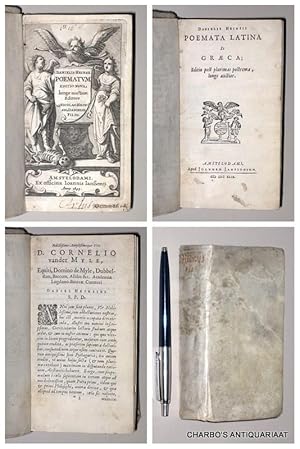
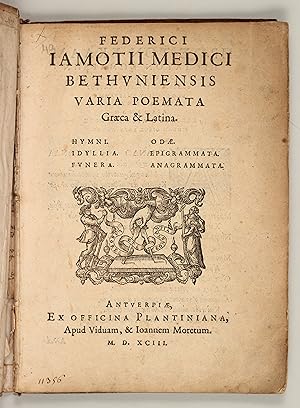

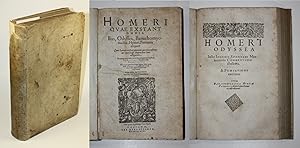
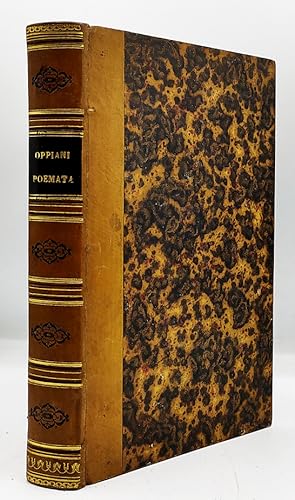
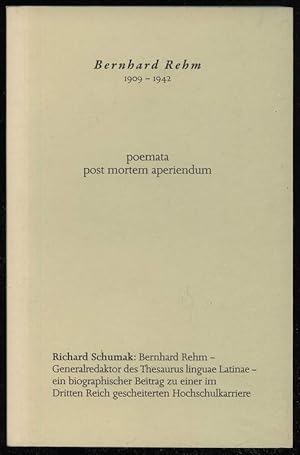
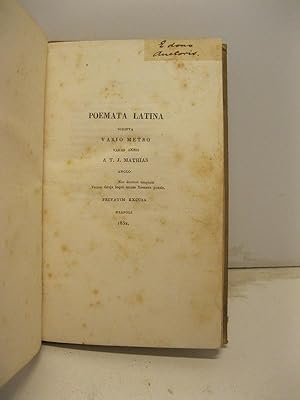
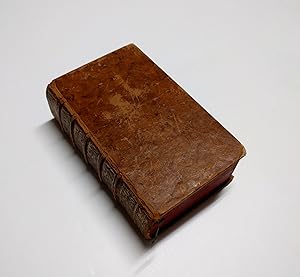
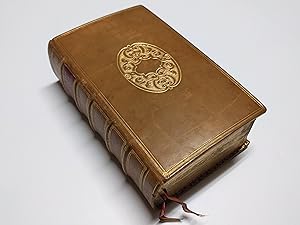

![Bild des Verkäufers für Aesopi Phrygis Fabulae, elegantissimis iconibus veras animalium species ad ivum adumbrantibus. Gabriae Graeci fabellae XLIII. [Greek: Batrachomyomachia] Homeri, hoc est, ranarum & murium pugna. [Greek: Galeomyomachia], hoc est, felium & murium pugna, fabla Graeca. Haec omnia cum Latina interpretation. Accesserunt Avieni antique auctoris fabulae. Editio postrema, ceteris castigatior.[Genève or Lyon], Jean de Tournes, 1619. 2 volumes bound as 1. 16mo. With the woodcut portrait of Aesop in a roundel on the title-page and 61 woodcuts (ca. 3.5 x 4.5 cm) in the text, illustrating the fables of Aesop, most after Bernard Salomon, but 22 from another series. Woodcut initials and ornaments. Text in two columns: Greek (left) and Latin (right).[With:] 2) THEOGNIS and others. [Greek text] Theognidis, Phocylidis, Pythagorae, Solonis & aliorum Poemata gnomica Opera Friderici Sylbrgii. Utrecht, Johannes I Janssonius van Waesberge, 1651. 12mo. With printer s device on title-page and some woodcut init zum Verkauf von ASHER Rare Books](https://pictures.abebooks.com/inventory/md/md30628103713.jpg)